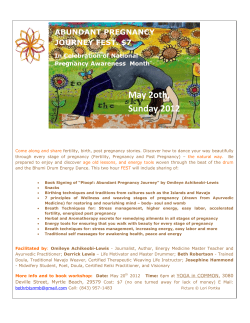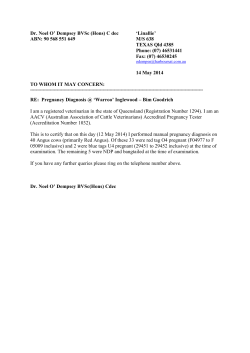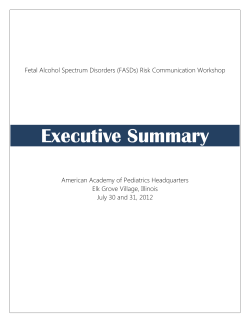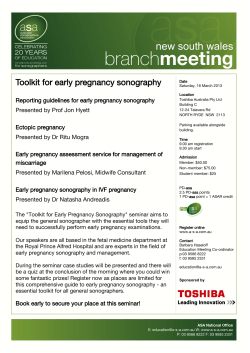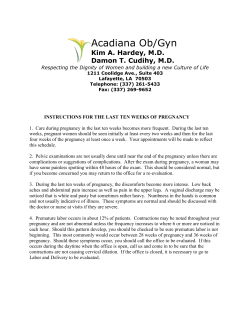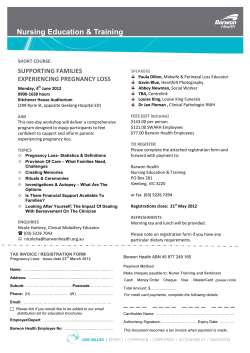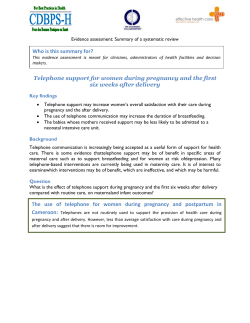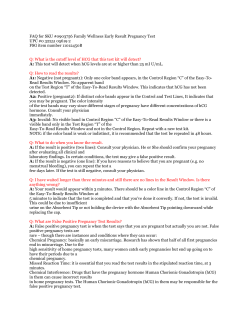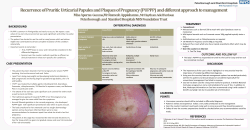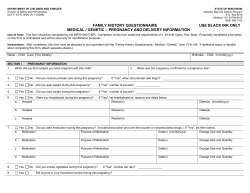
Gayla C. Winston, MPH, President & CEO
Gayla C. Winston, MPH, President & CEO Stephen L. Everett, MS, Director of Programs Indiana Family Health Council, Inc. Indianapolis, Indiana What is the Indiana Family Health Council? When was IFHC founded? Who can access IFHC services? Where are the Indiana Family Planning Resource locations? www.ifhc.org How can I network with these clinics? NOTE: The Indiana Data and Statistics are being compiled and will be added to the presentation on these slides. Compiled by: Jacki S. Witt, JD, MSN, WHNP-BC University of Missouri – Kansas City Project Director, Title X Clinical Training Center for Family Planning What is RLP? Why should we integrate RLP into clinical practice? How can we make RLP meaningful to individuals and the community? What barriers do the men & women in our clinic/community face when making RLPs? Planning for pregnancy – or not Access to health care services for prevention/health promotion, preconception planning & contraception Case finding of women with previous adverse pregnancy outcomes to reduce risk for future adverse outcomes Dialogue between health care staff & women/couples A set of interventions that aim to identify & modify biomedical, behavioral, & social risks to a woman's health or pregnancy outcome through prevention & management It is more than a single visit & less than complete well-woman care It includes care before a first pregnancy or between pregnancies (interconception care) 7 Why RLP? Early Prenatal Care is Not Enough Critical Periods of Development Critical Periods of Development Weeks gestation from LMP Most susceptible time for major malformation 4 5 6 7 8 9 10 11 12 Central Central Nervous Nervous System System Heart Heart Arms Arms Eyes Eyes Legs Legs Teeth Teeth Palate Palate External External genitalia genitalia Ear Ear Missed Period Mean Entry into Prenatal Care The heart begins to beat at 22 days after conception The neural tube closes by 28 days after conception The palate fuses at 56 days after conception Critical period of teratogenesis – Day 17 to Day 56 10 We had used condoms except one time! It wasn’t my fertile time My doctor said I couldn’t get pregnant I don’t believe in doing anything to stop from having children My boyfriend doesn’t like using condoms I thought if it’s God’s will, I would get pregnant I was using birth control pills ! Unintended: occur earlier than desired, 29% Intended, 51% Unintended: occur after women have reached their desired family size, 20% Approximately 6.4 million pregnancies per year Improve the health of each woman prior to conception by identifying risk factors Provide education Stabilize medical condition(s) to optimize maternal and fetal outcomes The process should be ongoing “Every woman – every time” Finer,2006 Improving Preconception Health & Pregnancy Outcomes All women & men of childbearing age have high reproductive awareness (i.e., understand risk & protective factors related to childbearing). All women have a reproductive life plan (e.g., whether or when they wish to have children, & how they will maintain their reproductive health). All pregnancies are intended & planned. All women & men of childbearing age have health coverage. All women of childbearing age are screened before pregnancy for risks related to the outcomes of pregnancy. Four Goals: 1. Improve the knowledge, attitudes, & behaviors of men & women related to preconception health 2. Assure that all women of child-bearing age in the U. S. receive preconception care services Four Goals (continued): 3. Reduce risks indicated by a previous adverse pregnancy outcome through interventions during the interconception period, which can prevent or minimize health problems for a mother or her future children 4. Reduce the disparities in adverse pregnancy outcomes Vision Improve health and pregnancy outcomes Goals Coverage – Risk Reduction Empowerment – Disparity Reduction Recommendations Individual Responsibility - Service Provision Access – Quality – Information – Quality Assurance Action Steps Research – Surveillance – Clinical interventions Financing – Marketing – Education and training U.S. maternal & infant mortality is higher than in many countries Despite more women receiving early prenatal care rates of preterm birth & low birth weight are increasing in U.S. Singapore Sweden Hong Kong Japan Finland Norway Czech Republic Portugal France Belgium Greece Germany Ireland Spain Switzerland Austria Denmark Israel Italy Netherlands England Australia New Zealand Scotland Canada Hungary Cuba N. Ireland Poland United States Slovakia IMR: Deaths per 1,000 live births 2.1 2.4 2.4 2.8 3 3.1 3.4 3.5 3.6 3.7 3.8 3.9 4 4.1 4.2 4.2 4.4 4.6 4.7 4.9 5 5 5.1 5.2 5.4 6.2 6.2 6.3 6.4 6.9 7.2 0 United States, Table 1: Health 2008 1 2 3 4 5 6 7 8 All Races………………………………….……. White ..……………………………………..….. Black ……………………………………………. Native American …………………………… Asian ……………………………………………. Hispanic ………………………………………… Mexican …..………………………………… Puerto Rican …………………………….… Cuban ……………………………………….. Central and South American …………. 2 National Center for Health Statistics, 2010 1995 2005 7.6 6.3 14.6 9.0 5.3 6.3 6.0 8.9 5.3 5.5 6.9 5.7 13.6 8.1 4.9 5.6 5.5 8.3 4.4 4.7 Delays in initiating prenatal care Reduced likelihood of breastfeeding Poor maternal mental health Lower mother-child relationship quality Increased risk of physical violence during pregnancy Pieces of the puzzle: Education Health Vocation/career Relationships/family Reproductive life plans Set against backdrop of culture, society, religion, economic status Encourage young people to develop a “RLP” by asking themselves questions: Do I want children and if so, how many and when? How will I feel if I cannot have children? How will I feel if I have an unwanted pregnancy? How do I feel about abortion? What do I most want to accomplish in life? How much education do I want? How compatible are my reproductive plans with my religious and moral beliefs? Hatcher, 1980 Is there scientific data to support it? Rubella vaccination Folic Acid HIV/AIDS screening supplements Management and Avoiding control of: teratogens: Diabetes Smoking Hypothyroidism Alcohol PKU Oral anticoagulants Obesity Isotretinoin Priority # 4: “Emphasizing the importance of counseling family planning clients on establishing a reproductive life plan, and providing preconception counseling as a part of family planning services, as appropriate” Evidence Consensus Guidelines Best Practice = Reproductive Life Plan for Everyone Preconception care is not being consistently delivered today ▪ Most clinicians don’t provide it ▪ Most insurers don’t pay for it ▪ Most consumers don’t ask for it Funding Staff buy in Patient buy in Time Competing priorities Need to know best strategies for your population Consider your population/community Statistics: unplanned pregnancy rates, infant & maternal morbidity & mortality Cultural preferences related to health care, pregnancy, social challenges Health care access Consider your setting’s characteristics Who counsels women? Your best educational methods? Social and mental health services? Coverage for contraceptives? RLP is patient-centered Makes no assumptions (not all want to contracept) Dynamic: plans & goals can & do change, sometimes from visit to visit Plans about having children are simple for no one, ambivalence is common RLPs are NEVER right or wrong* Reproductive life planning should be offered to everyone, irrespective of assumptions about an individual’s circumstances* Can increase perceived control of [reproductive] future Encourages use of behavioral change model for counseling Reframes conception Chance Choice Challenges us to make the FP interaction [more?] patientcentered Could decrease unintended pregnancies, short interconceptional periods & poor pregnancy outcomes Could increase women’s wellness in reproductive years & beyond Social marketing & health promotion for consumers [state and national] Clinical practice [individuals and couples] Public health and community [collaborations] Public policy and finance [state by state] Data and research [all levels] Issues Actions Focus • Diabetes • Folic Acid • Substance Use ● Obesity ● Testing or immunizations ● STI/HIV • Client education materials • Education for staff ● PSA/newsletter/radio • Analyze other resources (Health Dept, CDC, Title X, MOD, etc) • Individual/Couple ● Clinic/Agency • Community Collaborations ● State • National Current RLP services in your setting? RLP tools you need? Most effective ways to train staff? Strategies to maximize implementation Collaboration is essential to provide a comprehensive approach. Examples of organizations: Other Clinics & Doctor's Offices Faith Based Organizations Community Based Organizations WIC and social services sites Hospital Based Organizations Businesses (nail salons, hair salons, others) Do you hope to have any (or any more) children? If no, how will you prevent having more pregnancies? If yes, how many more children do you want, how would you like to space them, how do you plan to keep from getting pregnant until you are ready for the next child? How can I help you achieve your plan? Patient-centered Empowering Invites goal setting and action steps Tested with target population Short Culturally-sensitive, respectful tone If self-administered then appropriate for health and general literacy Makes no assumptions Folic Acid Supplements: Reduce the occurrence of neural tube defects by two thirds Rubella testing &/or immunization: Rubella immunization provides protective seropositivity & prevents the occurrence of congenital rubella syndrome HIV/AIDS: timely antiretroviral treatment can be administered, pregnancies can be better planned Hepatitis B: Vaccination is recommended for men & women who are at risk for acquiring hepatitis B virus (HBV) infection. Pertussis: very contagious & can cause serious illness―especially in newborns. Teen & adult vaccination is important, especially for families with (or planning) newborns. Diabetes: 3-fold increase in birth defects among infants of women with type 1 & type 2 diabetes, without management Hypothyroidism: Dosage of levothyroxine should be adjusted in early pregnancy to maintain levels needed for fetal neurological development Maternal PKU: Low phenylalanine diet before conception & throughout pregnancy may prevent mental retardation in infants born to mothers with PKU Obesity: Associated adverse outcomes include neural tube defects, preterm birth, c-section, hypertensive & thromboembolic disease STDs: have been strongly associated with ectopic pregnancy, infertility, & chronic pelvic pain Alcohol: Fetal alcohol syndrome (FAS) and other alcohol-related birth defects can be prevented. Anti-seizure drugs: Some anti-seizure drugs are known teratogens Isotretinoin : Use of isotretinoin in pregnancy results in miscarriage & birth defects Oral anticoagulants: Warfarin is a teratogen; medications can be switched before the onset of pregnancy Smoking: Associated adverse outcomes include preterm birth, low birth weight. Exercise: 30 minutes Vitamin: 400 mcg folic acid Educate yourself: medicines/toxins that can cause birth defects Repro Life Plan Yearly Dr’s visits: discuss physical & mental wellness Diet: vegetables, fruits, & whole grains Avoid tobacco, drugs, & alcohol Your partner, friends, & family as sources of support Everywomancalifornia.org Partners Practices (remember F-I-D-O) ▪ ▪ ▪ ▪ Folic Acid Immunizations Drugs Other Prevention of STDs Past History Pregnancy Plans Pregnancy Test Results STD Test Results Other? Could be presented in a way that offends women (or men) Care offered may not be consistent with plan (provider bias) Could be interpreted as suggesting who should or should not have children Can be treated by providers as static (“but last time you said you did not want kids”) Could be seen as ‘blaming’ a woman or man when their RLP is not carried out as planned Case Study #1 - Sonya is a 32 year old G6 P0330. Her LNMP was 5 weeks ago. She is at the health care center for a pregnancy test. What do you want to know about Sonya? Sonya’s prior pregnancies included: two miscarriages at 19 weeks, one preterm delivery at 26 weeks and one at 24 weeks, both resulting in early neonatal deaths She had one pregnancy termination at 9 weeks gestation Gynecologic history is significant for painful menses Family history is significant for adult onset diabetes (F) and hypertension (F & M) Does not use illicit drugs or drink alcohol Has a supportive 30 year old male partner who is HIV positive and doing very well What other questions do you have for Sonya ? Pregnancy intention • Contraception • Age • Health status ▪ Maternal outcome ▪ Fetal/newborn outcome Sonya and partner’s knowledge of her HIV status Safe conception Medications Use of tobacco? What can you do for her? Pregnancy prevention Screening Pregnancy planning Substance use HIV transmission prevention Health maintenance/ support Referrals Family history (including genetic) Pregnancy history Folic acid Case Study #2 – Annie is a 20-year old who presents for emergency contraception after ‘the condom broke’ two days ago. What do you want to know about Annie? Never been pregnant Never used prescription birth control method Sexually active X 3 years New boyfriend X 2 months (3rd partner in lifetime) BP: 130/88 P: 80 BMI: 35 Significant Family History: Father died age 48 – complications of diabetes What other questions do you have for Annie ? Pregnancy intention • Contraception Medications? Use of tobacco? Illicit drug use? What can you do for her? Pregnancy prevention options Pregnancy planning Screening for diabetes Screening for STDs Weight loss message Folic acid Initiate the Session Gather Information Understand the Client’s Perspective Provide Structure to the Session Build a Relationship Close the Session Resources for Reproductive Life Planning & Family Planning www.ifhc.org www.cdc.gov www.mchb.hrsa.gov www.everywomancalifornia.org www.ncpublichealth.com Ad Hoc Committee of PCCHC Select Panel on Reproductive Life Planning, Washington, DC, Nov 23, 2009. Canady, R.B., Tiedje, L.B. & Lauber, C. (2008). Preconception care and pregnancy planning. American Maternal Child Nursing Journal, 13 (2), 90-97. CDC Vaccine Information Statement (VIS) (Interim) MMR Vaccine (3/13/08) CDC Vaccine Information Statement (VIS) (Interim) d & Tdap Vaccines (11/18/08) Centers for Disease Control and Prevention. Recommendations to improve preconception health and health care - United States: a report of the CDC/ATSDR Preconception Care Work Group and the Select Panel on Preconception Care. Morbidity & Mortality Weekly Report. 2006;55:1-23. Retrieved March 4, 2011 from http://www.cdc.gov/mmwr/preview/mmwrhtml/rr5506a1.htm Cheng D, Schwarz E, Douglas E, et al. Unintended pregnancy and associated maternal preconception, prenatal and postpartum behaviors. Contraception. 2009 Mar;79(3):194-8. D’Angelo, D, Colley Gilbert B, Rochat R, et al. Differences between mistimed and unwanted pregnancies among women who have live births. Perspect Sex Reprod Health. 2004 Sep–Oct;36(5):192-7. Ecologic Model of Health. (Adapted from Healthy People 2020). Hatcher, R. (1980). Contraceptive Technology Update. 1(9): 131-132. Hernández Jennings, M. Preconception Health Care: Integrating Reproductive Life Plans into Title X Settings, Colorado Family Planning Initiative Conference, October 23, 2009 Hovell MF, Wahlgren DR, Adams MA. The Logical and Empirical Basis for the Behavioral Ecological Model. In RJ DiClemente, R Crosby, M Kegler, (eds.). Emerging Theories and Models in Health Promotion Practice and Research (2nd edition). San Francisco: Jossey-Bass Publishers; 2009. p. 415-49. Kendall, C. Afable-Munsuz, A. Speizer, I., Avery, A., Schmidt, N., & Santelli, J. (2005). Understanding pregnancy in a population if inner city women in New Orleans-Results of qualitative research. Social Science and Medicine. 60, 297-311. Kost K, Landry D, Darroch J. Predicting maternal behaviors during pregnancy: Does intention status matter? Fam Plann Perspect. 1998 Mar–Apr;30(2):79-88. Logan C, Holcombe E, Manlove J, et al. The consequences of unintended childbearing: A white paper [Internet]. Washington: Child Trends, Inc.; 2007 May [cited 2009 Mar 3]. Available from: http://www.childtrends.org/Files/Child_Trends-2007_05_01_FR_Consequences.pdf Moos, M-K. Establishing Some Foundations for the RLP Discussion. Presentation at the Office of Population Affair’s Expert Work Group Meeting Implementing Reproductive Life Planning Counseling in Family Planning Clinics. Sep 22-23, 2010. Moos, MK. (2003). Unintended pregnancies: a call for nursing action. Maternal Child Nursing. 28: 2531. National Campaign to Prevent Teen and Unplanned Pregnancy. Unplanned Pregnancy Rate in the U.S. Retrieved March 31, 2011 from http://www.thenationalcampaign.org/nationaldata/unplanned-pregnancy-birth-rates.aspx Kurtz, Suzanne, Calgary-Cambridge Observation Guide 1, University of Calgary, Alberta, Canada; MaKoul, Gregory Thomas, The SEGUE Framework, Northwestern University Medical School.
© Copyright 2025
